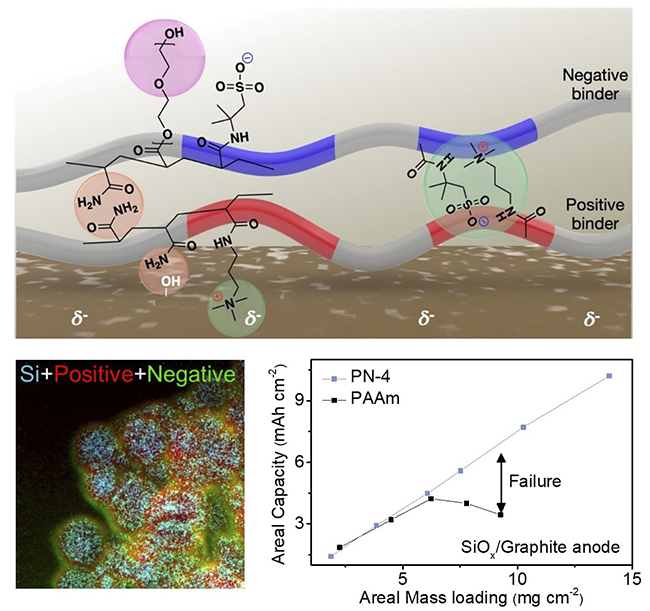| Mar 29, 2023 |
Revolutionary battery technology to boost EV range 10-fold or more
|
|
(Nanowerk News) As the EV market is witnessing skyrocketing growth, there is a surging demand for high-capacity batteries to enhance EV driving range. A joint research team from POSTECH and Sogang University has developed a functional polymeric binder for a stable, high-capacity anode material, promising a 10-fold increase in EV range.
|
|
Led by Professors Soojin Park (Chemistry) and Youn Soo Kim (Materials Science and Engineering) from POSTECH and Professor Jaegeon Ryu (Chemical and Biomolecular Engineering) from Sogang University, the team created a charged polymeric binder for a high-capacity, stable, and reliable anode material. This was accomplished by replacing graphite with a silicon (Si) anode combined with layering-charged polymers, ensuring stability and reliability.
|
|
The research was featured as the Front Cover Article in Advanced Functional Materials ("Layering charged polymers enable highly integrated high-capacity battery anodes").
|
 |
| Graphical abstract of this research.
|
|
High-energy-density Li-ion batteries require high-capacity anode materials like silicon, which can offer a capacity 10 times greater than graphite or other existing anode materials. However, the volume expansion of high-capacity anode materials during lithium interaction compromises battery performance and stability. Researchers have been exploring polymer binders to effectively control volumetric expansion.
|
|
Previous research primarily focused on chemical crosslinking and hydrogen bonding. Chemical crosslinking forms solid covalent bonds between binder molecules, but once broken, they cannot be restored. Hydrogen bonding is a reversible secondary bonding based on electronegativity differences, but its strength (10-65 kJ/mol) is relatively weak.
|
|
The new polymer leverages hydrogen bonding and Coulombic forces (attraction between positive and negative charges), which have a strength of 250 kJ/mol, much higher than hydrogen bonding, and are reversible for easy volumetric expansion control. The layering-charged polymers, with alternating positive and negative charges, effectively bind with the negatively charged surface of high-capacity anode materials. The team also introduced polyethylene glycol to regulate physical properties and facilitate Li-ion diffusion, resulting in a thick high-capacity electrode and maximum energy density in Li-ion batteries.
|
|
Professor Soojin Park remarked, "This research could significantly increase Li-ion batteries' energy density by incorporating high-capacity anode materials, extending the driving range of EVs. Silicon-based anode materials have the potential to boost driving range by at least ten times."
|

